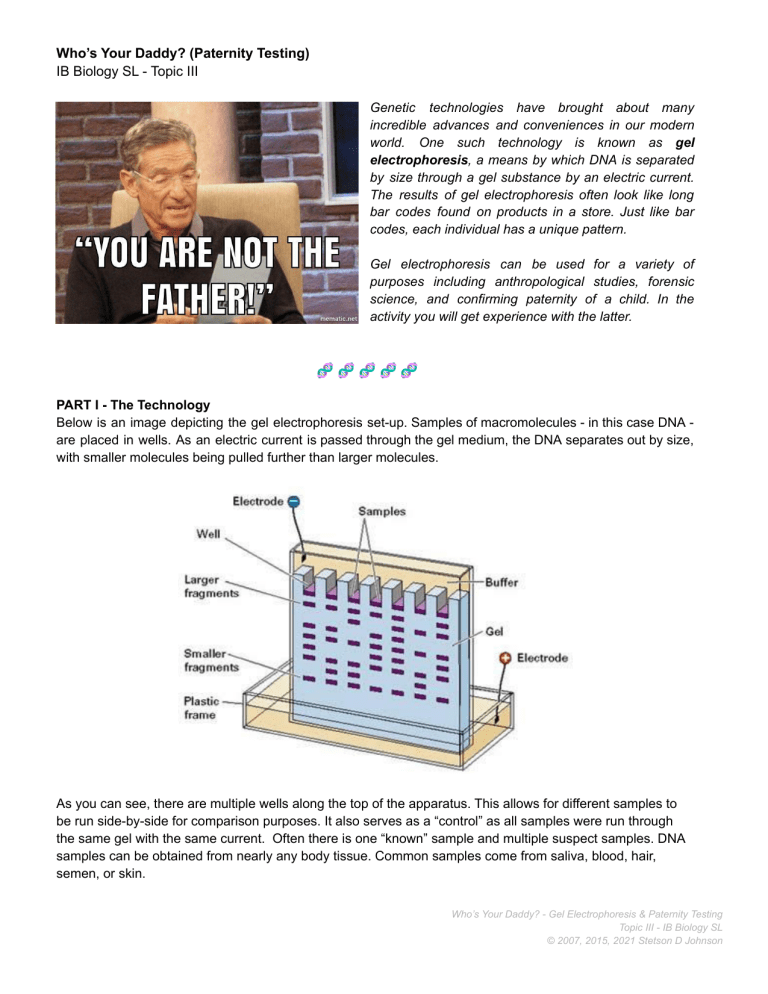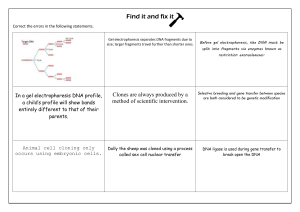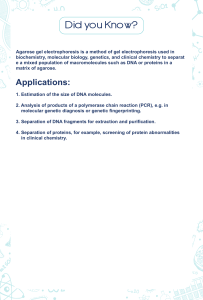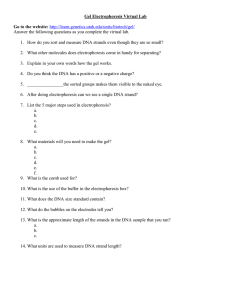
Who’s Your Daddy? (Paternity Testing) IB Biology SL - Topic III Genetic technologies have brought about many incredible advances and conveniences in our modern world. One such technology is known as gel electrophoresis, a means by which DNA is separated by size through a gel substance by an electric current. The results of gel electrophoresis often look like long bar codes found on products in a store. Just like bar codes, each individual has a unique pattern. Gel electrophoresis can be used for a variety of purposes including anthropological studies, forensic science, and confirming paternity of a child. In the activity you will get experience with the latter. 🧬🧬🧬🧬🧬 PART I - The Technology Below is an image depicting the gel electrophoresis set-up. Samples of macromolecules - in this case DNA are placed in wells. As an electric current is passed through the gel medium, the DNA separates out by size, with smaller molecules being pulled further than larger molecules. As you can see, there are multiple wells along the top of the apparatus. This allows for different samples to be run side-by-side for comparison purposes. It also serves as a “control” as all samples were run through the same gel with the same current. Often there is one “known” sample and multiple suspect samples. DNA samples can be obtained from nearly any body tissue. Common samples come from saliva, blood, hair, semen, or skin. Who’s Your Daddy? - Gel Electrophoresis & Paternity Testing Topic III - IB Biology SL © 2007, 2015, 2021 Stetson D Johnson Part II - Reading a Paternity Test * Usually a paternity test will involve at least three sets of DNA: the child, the mother, and the possible father. As the Law of Segregation shows, every individual passes on half of their genome to their offspring with the other half coming from the other parent. Thus, the child in a positive paternity test should be composed of equal parts of each parent. When reading a paternity test, it is important to focus on the child. Each “bar” in the child’s gel electrophoresis result show be accounted for, either from the mother or father. If there are sufficient unclaimed bars from the child, the man in question is likely not the father. 🧬 EXAMPLE #1: Is this man (F) the father of the child? Yes, it is highly probable that this is the father. Looking firstly at the child (C) bars, it is evident that each bar can be accounted for. While not a perfect 50% distribution, the statistical odds that this man will match the bars not matched by the mother is likely higher than another male paternity candidate. 🧬 EXAMPLE #2 Is this man (F) the father of the child? No. While one of the child’s (C) bars match those of the prospective father’s, there are many unaccounted for bars that match no one. * While gel electrophoresis can be used to test for maternity, usually this is known, so these types of findings generally are used to identify the father of a child. Who’s Your Daddy? - Gel Electrophoresis & Paternity Testing Topic III - IB Biology SL © 2007, 2015, 2021 Stetson D Johnson





